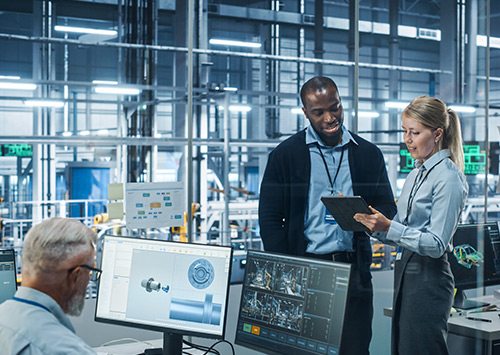- Services
Technology Capabilities
Technology Capabilities- Product Strategy & Experience DesignDefine software-driven value chains, create purposeful interactions, and develop new segments and offerings
- Digital Business TransformationAdvance your digital transformation journey.
- Intelligence EngineeringLeverage data and AI to transform products, operations, and outcomes.
- Software Product EngineeringCreate high-value products faster with AI-powered and human-driven engineering.
- Technology ModernizationTackle technology modernization with approaches that reduce risk and maximize impact.
- Embedded Engineering & IT/OT TransformationDevelop embedded software and hardware. Build IoT and IT/OT solutions.
- Industries
- GlobalLogic VelocityAI
- Insights
BlogsMarch 15, 2023GlobalLogicIf You Build Products, You Should Be Using Digital Twins
Digital twin technology is one of the fastest growing concepts of Industry 4.0. In the ...
 BlogsJanuary 25, 2023GlobalLogic
BlogsJanuary 25, 2023GlobalLogicDeploying a Landing Zone with AWS Control Tower – Part 3
In this post, we’re going to walkthrough some of the remaining post configuration tasks...
- About
Published on January 18, 2023How Smart Cars Will Change Cityscapes
View all articlesVitaliy VoloshchukSoftware Engineer, EngineeringShareRelated Content GlobalLogic25 June 2025
GlobalLogic25 June 2025 GlobalLogic25 June 2025View All Insights
GlobalLogic25 June 2025View All Insights GlobalLogic25 June 2025
GlobalLogic25 June 2025Let's start engineering impact together
GlobalLogic provides unique experience and expertise at the intersection of data, design, and engineering.
Get in touchCloud Based Platform EcosystemsData EngineeringEnd-to-End IoT SolutionsMobilitySmart cars are becoming more common all the time. Today, there are over 31 million cars worldwide with at least some level of automation, offering drivers a safer driving experience, improved fuel efficiency, and better parking options.They also improve cityscapes through their ability to communicate with other vehicles and infrastructure. In this way, smart cars are changing the way cities function – and the experiences people have within them.
But what exactly is a smart car? And how will smart cars change our cities?
What is a Smart Car?
Smart cars are equipped with advanced technologies such as sensors, cameras, GPS, and wireless communication devices. These features allow them to interact with each other and with road infrastructure, enabling smart cars to act as a conduit for useful information that helps drivers respond to traffic conditions.
Smart cars are improving safety, reducing congestion, and increasing mobility. As a result, these vehicles are helping to transform urban landscapes.
The rise of autonomous driving means fewer drivers will be needed to operate public transportation systems. In addition, traffic congestion will decrease significantly due to fewer traffic accidents caused by distracted drivers.
Recommended reading: Introduction to Autonomous Driving [Whitepaper]
A Smart City is One Where People Know the Value of Data
Consulting company PwC coined the term “data-driven city” to describe a smart city. The instantaneous collection, transmission, and analysis of information circulating in an urban space allow municipalities to radically change their approach to transportation management. It also impacts urban resource management (e.g., water, energy, etc.), safety improvements, environmental impacts, medicine production, and management of education and the other city services available for residents.
How is this being put into practice? New York City has a unified data collection and analysis system that feeds several effective city solutions, including a fire prediction system, garbage removal, and recycling. It also includes a health information system that collects data from citizens’ wearable devices (such as fitness trackers) and transfers it to medical institutions.
Another example is in Barcelona, where hundreds of sensors collect information on traffic, noise, electricity, and lights through an integrated system called Sentilo, which is in the public domain. This means that city authorities can make effective management decisions, and third-party businesses can develop additional services for residents.
Technological Breakthroughs and Cities of the Future
The IEEE published research in 2017 that defines a whole range of technological trends that will influence the cities of the future, including:
Internet of Things
Smart sensors are enabling the gathering of more information from the environment. According to global forecasts, there will be 75.4 billion connected devices by 2025. IoT technology allows real-time monitoring of all city life aspects: traffic speed, outdoor security, resource consumption, etc.
Cloud Technologies
With the amount of generated data growing, there will be a need for rapid and qualitative processing. Cloud application systems will become the brain of a city, helping city managers make effective decisions (e.g., traffic regulation) based on the analysis of terabytes of data.
Recommended reading: Cloud-Driven Innovations: What Comes Next?
Open Data
By providing easier access to information, city authorities not only make communication with residents more transparent but also create the basis for new businesses, for example, developing mobile applications to monitor the environmental situation in the city.
At the same time, a smart city is a complex ecosystem that unites technological as well as human and institutional aspects. The digital transformation of cities can only happen with active involvement from municipal authorities, businesses, the local IT industry, and the citizens themselves.
Communication Between Cars in the City of the Future
The digital transformation of the automotive industry is yet another milestone in smart city development. The growing popularity of electric cars — as well as experiments with uncrewed vehicles by Tesla, Google, Mercedes, and other companies — is perhaps one of the most discussed technological topics in the media.
In the cities of the future, cars will not disappear. However, the volume of personal cars on city streets will decrease gradually as rideshare apps like Uber, car-sharing services, and autonomous vehicles for carpooling replace them. Car design will change radically, and the experience of being a passenger in an autonomous vehicle will become more comfortable.
Unlike cars with internal combustion engines, electric cars will not pollute the city and create noise. Self-driving vehicles will save citizens from an excessive number of unsightly parking lots near the sidewalks, as there will be no need to leave cars near the office.
For several years, GlobalLogic has been developing technologies for smart cities in cooperation with automotive corporations and telecom operators. Based on our expertise, we imagine how a city might develop in 5-10 years and then experiment with related technologies. One of our predictions is that all cars will eventually be able to communicate with each other – and we already know how this will work in practice.
Communication between smart cars and smart road infrastructure will make the road a safer place to drive. In critical situations, each second matters, so the sooner drivers receive the information they need, the more likely they will avoid an accident. Communication technologies between cars will allow the driver to know about everything happening around them from a specific distance.
Recommended reading: User Experience as a Key Factor in the Automotive Industry
Incorporating Technology
So, how is this realized technologically? Cars will be able to communicate through the vehicle-to-everything (V2X) protocol, creating a powerful Wi-Fi network with instant data transfer within 1 km around themselves.
How is this realized in practice? Using an interactive simulation environment that we developed, we tested a variety of application cases, such as:
- The driver wants to change lanes but immediately receives an alert about a car speeding in that lane. This notification prevents drivers from making dangerous maneuvers.
- A smart road infrastructure receives traffic data from cars and can create an alternate route for the driver.
- An ambulance sends a signal about driving in a certain lane. Then all drivers receive the notification to make room for the ambulance to pass. Afterward, a smart traffic light switches to green to let the ambulance pass safely through the intersection.
- A car with a punctured tire can signal assistance to all passing cars. If the driver of a passing car cannot help, the car transmits the signal to the next vehicle.
Past Innovation
How fast will smart cars be able to communicate? And what will happen to cars that cannot? Let’s discuss the history of mobile phones.
When they first appeared, it seemed expensive and rather pointless to purchase them since few people had a phone that you could call. But over time, more and more people became mobile users, and mobile phones became more affordable. Now, they are our main means of communication.
The same future is likely to follow for automotive communication technologies.
First, city authorities will encourage residents to install the necessary equipment and software for the car. Then cars will come off the production line with already-integrated communicative capabilities.
Future Innovation
At GlobalLogic, we’ve noticed numerous automotive trends and innovations that will change how we approach creating vehicles.
The widespread integration of Automotive Open System Architecture (AUTOSTAR), the personalization of cars through subscription models, autonomous vehicles, and augmented reality are just a few examples of the factors and trends influencing how smart cars will change our cityscapes in the years to come.
These advances will soon be able to create a fully autonomous car, helping us to create smarter cities and safer roads for drivers, too.
Learn more:
FAQs
Smart cars are vehicles equipped with advanced technology for automation, connectivity, and enhanced driving experiences.
They are expected to reduce traffic congestion, improve road safety, and enhance the efficiency of transportation systems.
Technologies include autonomous driving systems, IoT connectivity, AI, and advanced driver-assistance systems (ADAS).
Many smart cars are electric or hybrid, offering lower emissions and promoting environmental sustainability.
Challenges include infrastructure compatibility, data privacy, security concerns, and public acceptance.
